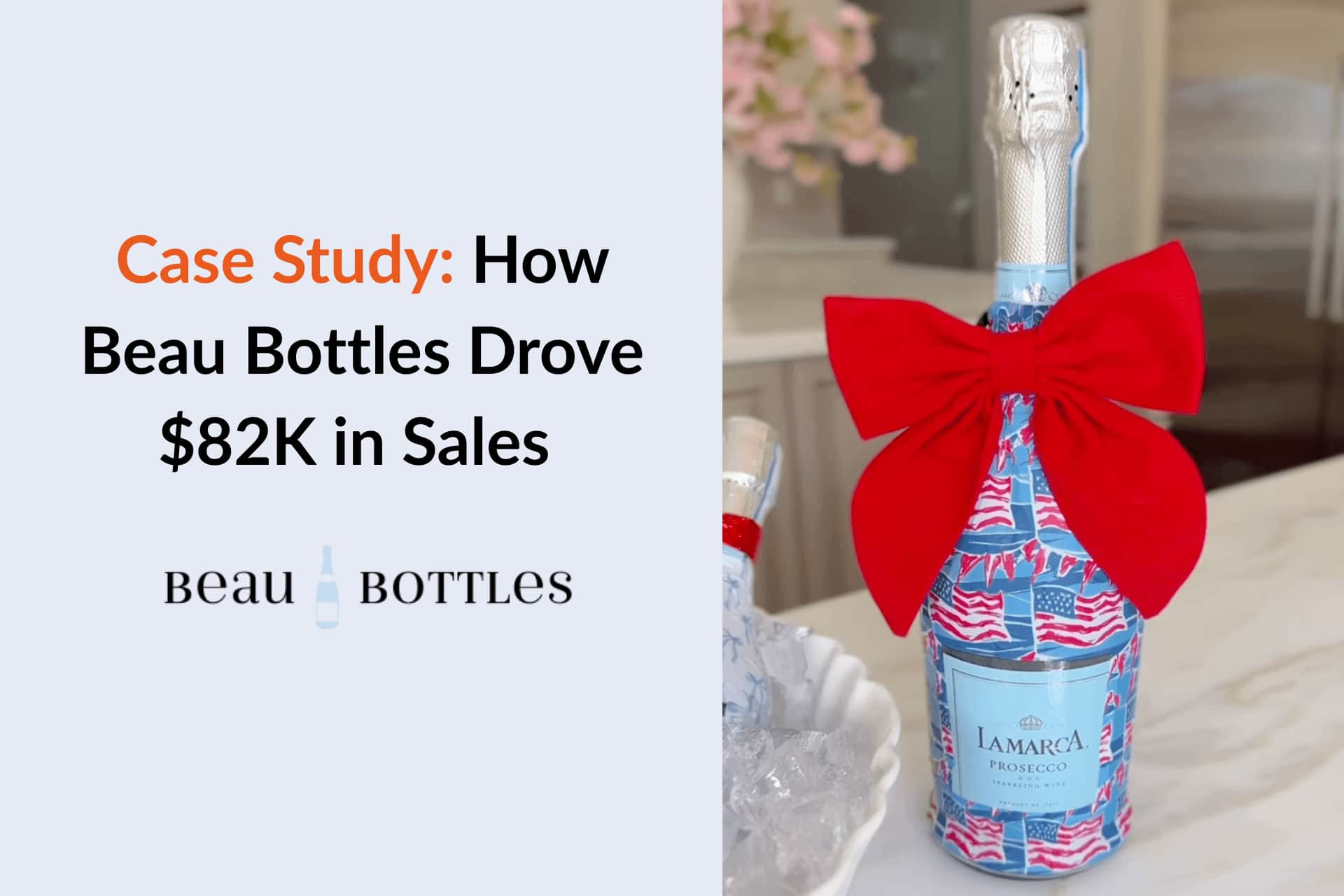





One Impression is a popular influencer marketing platform known for its comprehensive features, but it's not without its drawbacks. Some of the common complaints include the platform’s limited customization options, a less intuitive user interface, and customer support that has room for improvement. These issues have led many brands to explore alternatives, seeking platforms that offer more flexibility, better ease of use, and improved customer service.
In this article, we’ll explore the top 10 alternatives to One Impression, providing insights into their features, pricing, and unique strengths. Here's a quick look at the alternatives we’ll cover:
When evaluating influencer marketing platforms, many users have highlighted recurring frustrations with One Impression on forums like Reddit and review sites such as G2. These issues explain why brands often consider switching to alternative solutions.
One of the most common concerns is the reliability of influencer data. Users report that the platform depends heavily on scraped information, which can lead to misleading engagement rates and performance insights. This creates a lack of trust when planning campaigns.
Another pain point is the user interface. The dashboard is often described as busy and difficult to navigate, presenting too many options without clear prioritization. This makes it harder for marketers to quickly extract the information they actually need.
Even experienced marketers find the platform challenging to use. The setup and workflow demand significant time to understand, and small teams especially struggle with the steep learning curve. This reduces efficiency and discourages adoption.
Finally, some users point out that One Impression does not differentiate enough from other platforms in an already crowded market. With overlapping features and little innovation, it can feel redundant compared to competitors that offer clearer value or niche advantages.
Our comparison focuses on several key aspects:
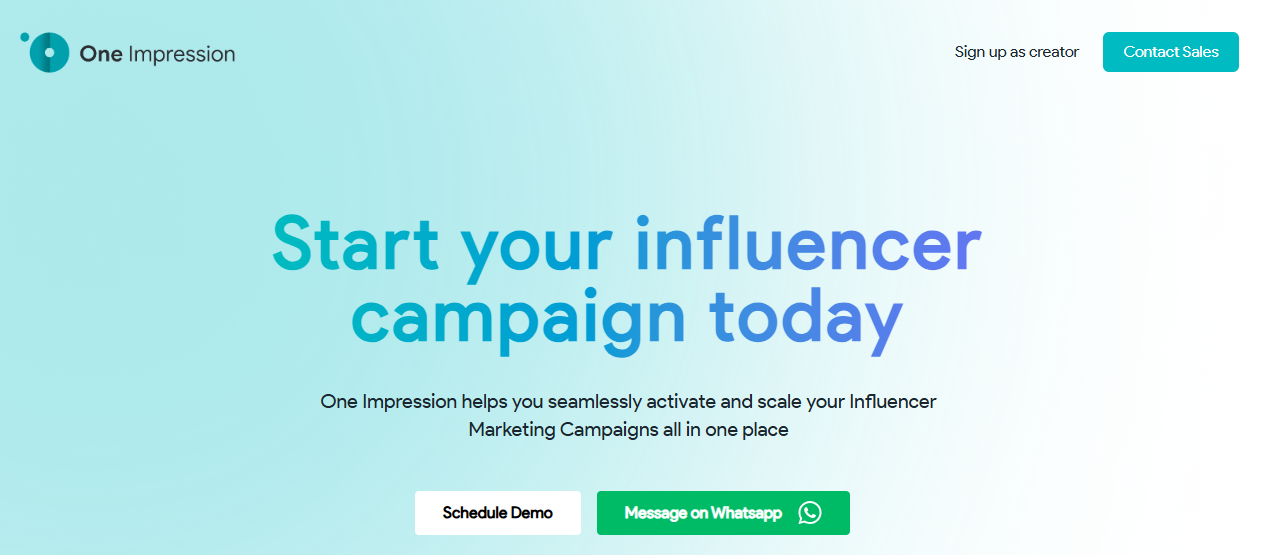
Best For: One Impression is best for brands (especially D2C / e-commerce) and marketing teams seeking a full-stack creator/influencer marketing platform that accelerates campaign setup, discovery, collaboration, and performance tracking—with less dependence on agencies or manual processes.
Platform Coverage:
Pricing: The platform offers custom / flexible pricing depending on campaign size, brand needs, etc. Based on our research, there is no publicly listed, fixed plan pricing (monthly tiers etc.) clearly published as of latest info. Brands need to contact for pricing & plan options.
Reviews: 4.5 / 5.0 (Capterra)
Ease of Use (UX/UI): One Impression offers a clean dashboard that covers the influencer campaign lifecycle—discovery, creator communication, content approval, and performance tracking. However, several users mention that while the interface looks simple, the actual navigation can feel less intuitive, with certain workflows (like analytics or reporting) requiring extra steps.
Customer Support: Support is available via email, phone, in-app / helpdesk, and they maintain working hours (e.g. IST office hours) for brands/creators. Some reviews note there’s room for improvement in certain aspects (e.g. more clarity around metrics, more proactive support) but overall sentiment is positive.

Best For: Influencer Hero is best for eCommerce brands and D2C businesses looking to scale their influencer marketing campaigns with a seamless, all-in-one platform that combines advanced influencer discovery, AI-powered outreach, and robust CRM features for enhanced campaign management.
Platform Coverage:
Pricing: Influencer Hero offers flexible pricing plans to accommodate growing brands. All plans include core features and can scale as the influencer program grows.
Reviews: 5.0 / 5.0 (Capterra)
Ease of Use (UX/UI): Known for its intuitive design, Influencer Hero offers a user-friendly interface with a streamlined dashboard. The platform makes it easy for users to navigate through automated workflows, customizable email templates, and efficient campaign tracking.
Customer Support: Influencer Hero’s customer support is one of its standout features. It provides 24/7 real-human live chat, responsive email support, and an extensive Help Center filled with written and video tutorials. Every plan includes a dedicated account manager, and Pro plan users get access to a private Slack channel for continuous support and strategy consultations to guide growth.
While One Impression excels with a massive creator network and rapid campaign activation, its usage-based pricing model can be unpredictable, often making budgeting difficult for smaller brands. The platform is focused heavily on speed and scale, but sometimes lacks deeper creative strategy support.
Influencer Hero, on the other hand, offers a transparent subscription pricing model with flexible plans starting at $649/month, making it easier for businesses to scale predictably. Unlike One Impression, it provides AI-powered outreach, advanced CRM automation, and multi-platform eCommerce integrations, which allow brands to manage everything from gifting to affiliate sales in one place.
The biggest difference is in customer support: while One Impression provides standard assistance, Influencer Hero includes a dedicated account manager, 24/7 live chat, and even private Slack access for Pro users. For brands looking for long-term partnerships, scalability, and comprehensive campaign management, Influencer Hero is the stronger choice.
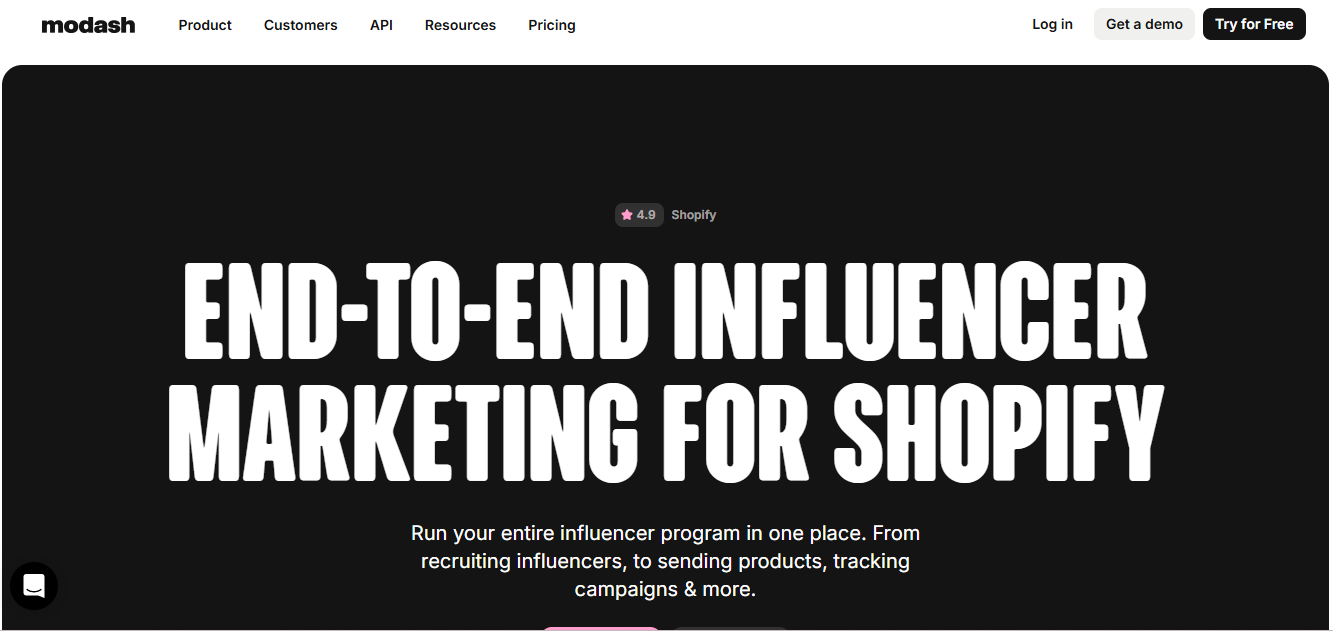
Best For: Modash is best for eCommerce brands on Shopify and D2C businesses looking to scale influencer marketing with automated gifting, affiliate tracking, and direct payments while leveraging a massive database of 350M+ creators.
Platform Coverage:
Pricing: There are different plans and options.
Reviews: 4.7/5 (G2)
Ease of Use (UX/UI): Users find Modash’s interface highly intuitive, with streamlined workflows from influencer discovery to campaign tracking. Its advanced filters and AI-powered search make it easy to narrow down creators, while the dashboard provides clear visibility into outreach and affiliate sales.
Customer Support: Modash is praised for its onboarding and ongoing support, with dedicated account managers available via WhatsApp and email. Although some users note limited self-service options during the AI upgrade, the personalized assistance ensures smooth campaign execution.
When comparing One Impression and Modash, the most striking difference lies in pricing models. One Impression works on a transactional commission structure, where costs vary depending on campaign size, while Modash offers predictable subscription plans starting at $199/month and managed services at $1,000/month, making budgeting clearer.
In terms of features, One Impression emphasizes speed and a massive global creator network, but it lacks deeper strategic and affiliate-focused tools. Modash, by contrast, specializes in influencer discovery, Shopify gifting, affiliate tracking, and automated payouts, making it more appealing to eCommerce and D2C brands.
Finally, while One Impression provides automation for campaign execution, Modash offers stronger AI-powered discovery, lookalike search, and a "Find Your Fans" tool, which help brands identify authentic partnerships. If you want global scale and fast execution, One Impression is a solid choice; but if you need Shopify integrations, affiliate automation, and predictable pricing, Modash is the better option.

Best For: Upfluence is best for eCommerce and Amazon sellers looking to scale influencer and affiliate programs while directly attributing sales through native integrations. Brands that want an all-in-one platform for discovery, outreach, campaign tracking, and payments will benefit most.
Platform Coverage:
Pricing:
Reviews: 4.5/5 (G2)
Ease of Use (UX/UI): Users highlight that Upfluence offers a robust yet intuitive dashboard with advanced filters to narrow down influencer searches across multiple platforms. While the platform is comprehensive, beginners may experience a learning curve when setting up their first campaigns. Overall, the workflow is designed to streamline everything from discovery to tracking without leaving the platform.
Customer Support: Upfluence provides dedicated account managers and support tailored to onboarding and scaling campaigns. Users report reliable customer service with clear communication, though some mention the annual contracts limit flexibility to cancel if support expectations aren’t met.
When comparing One Impression and Upfluence, one of the most significant differences is pricing structure. One Impression operates on a transactional commission model, where brands pay based on campaign activity. In contrast, Upfluence has a fixed subscription price starting at $1,276/month, which, while expensive, provides predictable costs with no commission fees.
In terms of features, One Impression excels in campaign speed and its vast creator marketplace, offering quick quotes and a wide range of global creators. However, Upfluence offers stronger eCommerce integrations with Shopify and Amazon, enabling brands to directly measure influencer-driven sales and ROI—an area where One Impression falls short.
Finally, while One Impression is ideal for brands prioritizing speed and scale, Upfluence is better suited for businesses seeking deep sales attribution, affiliate tracking, and long-term customer-influencer conversions. For D2C and Amazon sellers in particular, Upfluence provides more comprehensive value.

Best For: Captiv8 is best for large enterprises and global brands that want advanced influencer discovery, campaign tracking, and competitive intelligence at scale. Its features are designed for teams managing multiple campaigns simultaneously and seeking deep analytics integration.
Platform Coverage:
Pricing: There are different pricing options:
Reviews: 4.1/5 (G2)
Ease of Use (UX/UI): Users note that Captiv8 offers a robust but complex platform, with powerful search filters and reporting options that require some time to master. The ability to collaborate directly within creator profiles and lock filters for future use helps streamline workflows, but the platform can feel overwhelming for smaller teams. Overall, it’s considered effective for enterprises but less intuitive for beginners.
Customer Support: Customer support is an area where Captiv8 struggles, as reports highlight unresponsive service and unresolved account issues. Both brands and creators have raised concerns on forums about payment problems and a lack of responsiveness from the support team. While enterprise accounts may receive more attention, smaller clients often find the support lacking compared to competitors.
One Impression focuses on speed, affordability, and campaign automation, with a pay-as-you-go pricing model that avoids heavy upfront commitments. It offers access to 7M+ creators globally and enables campaigns to launch up to 3× faster and 30% cheaper, making it more accessible for mid-sized brands.
By contrast, Captiv8 requires a $25K annual commitment plus additional fees, positioning itself firmly in the enterprise space. While Captiv8 excels in deep analytics, competitor intelligence, and advanced filtering, its rigid pricing and ongoing customer service issues limit accessibility for smaller brands.
For brands needing flexible, fast, and affordable influencer campaigns, One Impression may be a better choice. However, if your company has a large budget and requires enterprise-level analytics and storefront features, Captiv8 could provide more strategic insights and competitive edge.

Best For: Enterprise-level brands and agencies managing global, large-scale influencer campaigns across multiple platforms. Especially strong for companies needing full lifecycle support, from discovery to reporting, with high compliance standards.
Platform Coverage:
Pricing: There are different plans:
Reviews: 4.7/5 (G2)
Ease of Use (UX/UI): Users report CreatorIQ as highly comprehensive but note that the platform can feel complex at first due to the breadth of features. However, once onboarded, the interface offers customizable dashboards, advanced filters, and efficient approval workflows that streamline campaign management. The learning curve is noticeable but rewarded with strong functionality for scaling.
Customer Support: CreatorIQ is well-regarded for its dedicated onboarding and strategic support. Every client gets an implementation manager and customer success team, which includes quarterly planning and strategy sessions. Users appreciate that support goes beyond technical troubleshooting to include campaign optimization and industry insights.
One Impression focuses on rapid campaign execution through its large creator network and usage-based pricing, making it attractive for short-term, performance-driven campaigns. However, its model can lead to unpredictable costs and it doesn’t provide the same depth in analytics or CRM functionality.
CreatorIQ, in contrast, offers an end-to-end enterprise-grade platform with advanced discovery, reporting, and payment compliance features. While pricing starts higher at $2K–$5K+/month on annual contracts, brands benefit from real-time API data, customizable dashboards, and dedicated strategic support.
For brands seeking scalability, compliance, and long-term influencer relationship management, CreatorIQ is a stronger option. For those prioritizing budget flexibility and quick activations, One Impression might be a better short-term fit.

Best For: HypeAuditor is best for brands and agencies that prioritize data-driven influencer marketing with detailed fraud detection, audience insights, and customizable campaign tracking. It works well for eCommerce brands, SaaS companies, and agencies managing multiple influencer campaigns across Instagram, TikTok, YouTube, Twitch, X, and Snapchat.
Platform Coverage:
Pricing: HypeAuditor’s pricing is customizable, with the standard “Business” plan starting at around $10,000/year. Pricing can be adjusted based on the number of reports, active campaigns, and platform usage. They also offer a 24–48 hour free trial for new users.
Reviews: 4.6/5 (G2)
Ease of Use (UX/UI): Users find HypeAuditor’s dashboard intuitive once onboarded, with clear campaign tracking and influencer vetting tools. However, some report that its depth of analytics can feel overwhelming for beginners, requiring a learning curve to unlock its full potential. The interface is built for professionals who value data precision over simplicity, making it especially useful for analytics-heavy teams.
Customer Support: HypeAuditor offers customized onboarding, responsive email support, and training sessions for new users. While customer support is generally praised for being knowledgeable and solution-oriented, some users mention that complex questions take longer to resolve due to the technical depth of the platform. Enterprise users receive more personalized assistance compared to entry-level accounts.
When comparing One Impression and HypeAuditor, the biggest difference lies in their approach to influencer campaigns. One Impression emphasizes a managed marketplace model, delivering pre-vetted influencers for brands, while HypeAuditor focuses on data analytics, fraud detection, and customizable influencer search.
In terms of pricing, One Impression offers predictable managed service packages (around $1,000/month for 30–40 influencers), making it more budget-friendly for small and mid-sized brands. HypeAuditor, however, starts at ~$10K/year for its Business plan, which includes 2,000 reports but may feel restrictive for smaller teams.
For brands prioritizing cost efficiency and fast influencer onboarding, One Impression is the better option. On the other hand, if you need in-depth audience analytics, fraud prevention, and cross-platform data insights, HypeAuditor provides the stronger toolkit despite its higher entry cost.

Best For: GRIN is best for eCommerce and DTC brands on Shopify, WooCommerce, or Magento that want to run influencer, affiliate, and creator programs fully in-house. The platform is particularly strong for businesses that want to own influencer relationships rather than relying on marketplaces.
Platform Coverage:
Pricing:
Reviews: 4.5 / 5.0 (G2)
Ease of Use (UX/UI): Most users describe GRIN’s UI as straightforward and familiar for eCommerce teams, with deep integrations into online stores and affiliate setups. However, the dashboard can feel overwhelming for new users because of the many modules available. Still, once onboarded, teams appreciate the ability to keep everything in one place—from influencer CRM to payments.
Customer Support: Customer support is praised for dedicated account managers and responsive onboarding help. Users note that support goes beyond technical fixes, offering campaign strategy guidance. On the flip side, smaller brands sometimes feel that response times can lag when compared with more lightweight platforms.
One Impression and GRIN take two very different approaches to influencer marketing. One Impression works on a marketplace model, giving brands access to over 7 million creators globally with quick quotes and automated campaign execution. GRIN, on the other hand, is not a marketplace—instead, it is built for brands that want to own influencer relationships and integrate campaigns directly with their eCommerce platforms .
When it comes to pricing, One Impression charges commission-based fees on each transaction, making it more accessible for brands with flexible budgets. GRIN uses a subscription-based model with premium pricing, which may be better for larger eCommerce companies that want all-in-one CRM, affiliate tracking, and payment automation under one roof.
In short, brands looking for speed, scale, and marketplace access will prefer One Impression, while those seeking long-term creator partnerships, deep eCommerce integrations, and affiliate ROI tracking will find GRIN a stronger choice.
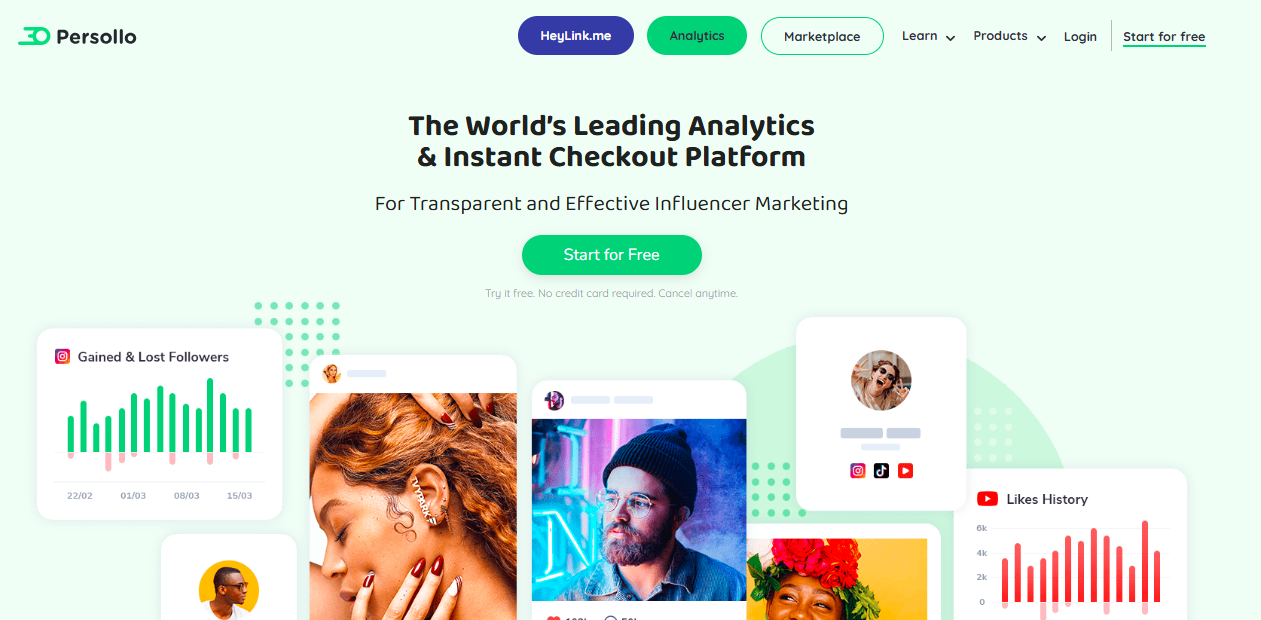
Best For: Persollo is best suited for eCommerce brands and D2C businesses seeking to scale influencer-driven sales with instant checkout and shoppable content. It’s particularly strong for brands focused on social commerce and conversion tracking through influencer-led campaigns.
Platform Coverage:
Pricing: Based on our research, Persollo offers different plans and options.
Reviews: No verified public reviews available on major platforms such as G2, Capterra, or Trustpilot.
Ease of Use (UX/UI): Users often note that Persollo offers a clean and straightforward dashboard with a focus on fast campaign launches and easy performance tracking. Its instant checkout and shoppable link system reduce complexity for both brands and influencers. However, some users feel the interface is more transactional and lacks the depth of traditional influencer CRMs.
Customer Support: Persollo provides responsive support via email and chat, with a team that helps guide brands through social commerce integrations. While customers generally find the team helpful and proactive, some reviews indicate that advanced strategy or campaign consulting is more limited compared to full-service influencer platforms.
While One Impression focuses on speed, scale, and its 7M+ global creator network, Persollo positions itself more as a conversion-first platform with instant checkout and shoppable links. This means One Impression is better suited for brands prioritizing reach and automation, whereas Persollo is ideal for brands looking to drive measurable sales directly through influencer content.
In terms of pricing, One Impression operates on a transactional commission model, offering quotes per campaign, while Persollo emphasizes flexibility with affiliate, gifting, and direct payment models. For small and mid-sized eCommerce brands, Persollo may be the more budget-friendly choice due to its focus on ROI-driven campaigns.
Ultimately, brands that want a broad influencer network and full campaign automation may prefer One Impression, while those aiming for conversion tracking and seamless social commerce integration will find Persollo the stronger fit.
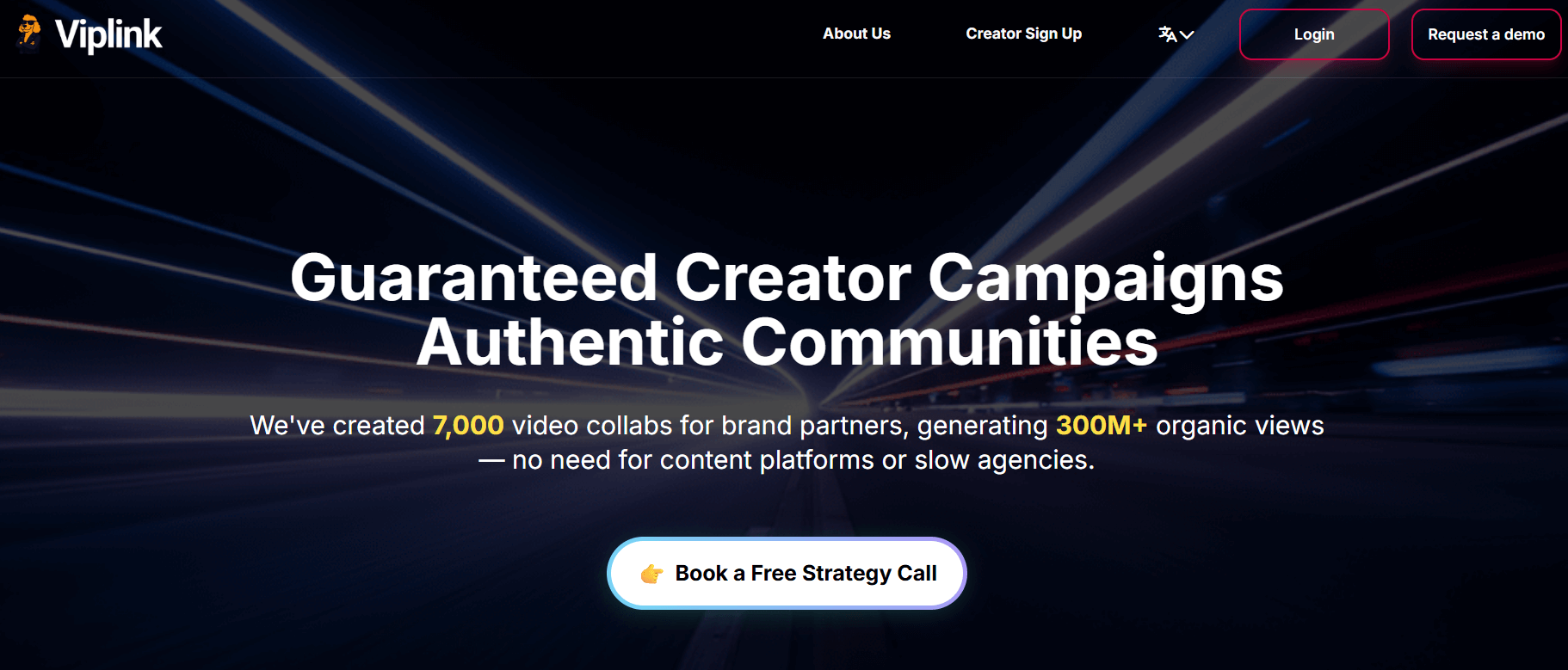
Best For: Viplink AI is best for eCommerce brands and consumer-focused companies that want to leverage AI-driven influencer selection and campaign optimization. It’s particularly strong for brands looking to automate large parts of influencer discovery and engagement while scaling campaigns efficiently.
Platform Coverage:
Pricing: No upfront fees; payment is only required once you approve creators and content. However, brands have to pay an additional fee—amount not publicly disclosed—based on what is paid to each creator.
Reviews: 4.4/5.0 (G2)
Ease of Use (UX/UI): Users highlight Viplink AI’s intuitive dashboard and streamlined workflows, making influencer selection and campaign tracking straightforward. Its AI-powered recommendations help reduce manual work, though some users mention a slight learning curve when setting up advanced campaign parameters.
Customer Support: Customer support receives positive feedback for responsiveness, with quick answers through chat and email support. However, users occasionally report that more complex technical issues take longer to resolve, indicating room for deeper technical onboarding and support materials.
When comparing One Impression with Viplink AI, the key difference lies in their approach to scale vs. AI automation. One Impression positions itself as a full-stack influencer marketing platform with 7M+ global creators and a focus on speed and cost efficiency, offering campaigns that run 3× faster and up to 30% cheaper. Viplink AI, on the other hand, emphasizes AI-driven discovery and content prediction, making it ideal for brands that prioritize automation and predictive performance.
In terms of pricing, One Impression follows a transactional commission model with transparent quotes and no subscription fees, which works well for brands running campaigns at varying volumes. Viplink AI, however, ties its pricing more closely to usage and advanced AI features, which can become more expensive for high-volume campaigns but may provide deeper ROI insights through predictive analytics.
For brands seeking a massive creator network and rapid campaign execution, One Impression is the stronger choice. But for companies wanting AI-powered insights, shoppable media integrations, and predictive performance tracking, Viplink AI delivers advanced functionality that may better optimize long-term influencer strategies.
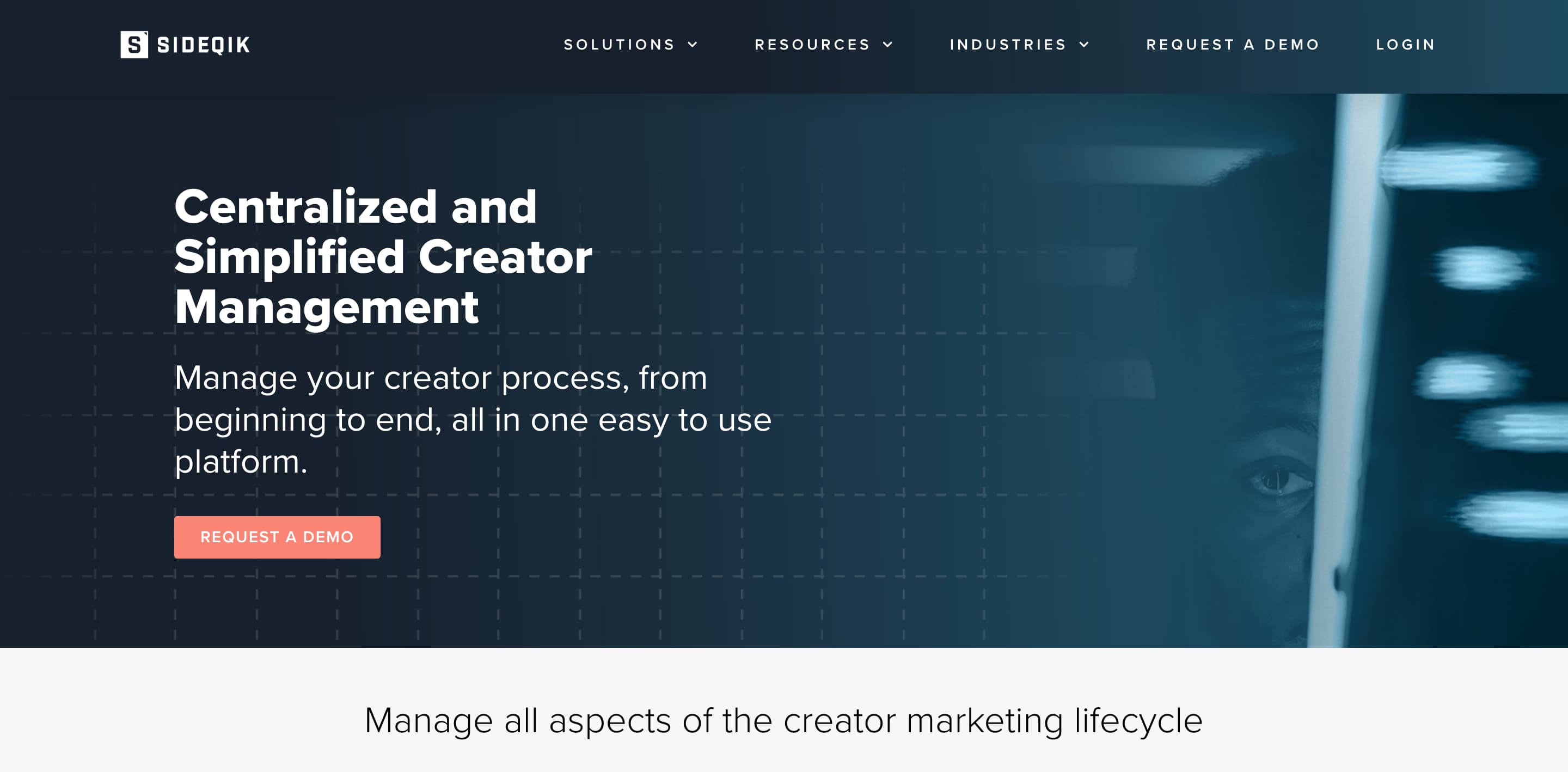
Best For: Sideqik is best for brands and agencies seeking advanced audience insights and data-driven influencer campaigns. It works especially well for eCommerce, gaming, and lifestyle brands that want to focus on ROI through deep analytics and attribution.
Platform Coverage:
Pricing: Undisclosed.
Reviews: 4.2 / 5.0 (G2)
Ease of Use (UX/UI): Users report that Sideqik’s interface is clean and professional, though it can feel overwhelming at first because of its breadth of features. Once accustomed, the dashboard makes it easy to manage influencer campaigns, analyze performance, and handle reporting in one place.
Customer Support: Customer support is described as responsive and knowledgeable, with strong onboarding and training resources. However, some users mention that smaller brands may feel less prioritized compared to larger enterprise clients.
When comparing One Impression vs Sideqik, the key differences lie in focus and pricing. One Impression is designed for speed, affordability, and scale, allowing brands to run influencer campaigns up to 3× faster and 30% cheaper than traditional agencies. Sideqik, on the other hand, emphasizes data-driven campaigns with advanced analytics, making it more attractive for enterprise brands that prioritize ROI measurement and attribution.
Pricing is a major factor: One Impression offers a transactional, commission-based model with no subscription barrier, making it suitable for both startups and large brands on a budget. Sideqik, however, is positioned at a premium price point, which may be out of reach for smaller businesses.
In short, choose One Impression if you want affordability, speed, and seamless execution, but go with Sideqik if your priority is advanced analytics, ROI attribution, and deep audience insights.
Exploring One Impression alternatives reveals a range of platforms catering to different needs—whether it’s enterprise-grade analytics, niche UGC solutions, or all-in-one campaign management. While One Impression stands out for its affordability, speed, and marketplace scale, other platforms bring unique strengths such as advanced ROI tracking, social listening, or specialized influencer discovery.
Among the alternatives, Influencer Hero consistently emerges as one of the strongest options. As an all-in-one influencer marketing software, it covers everything from influencer discovery and AI-powered outreach to affiliate tracking and analytics—making it a complete solution for brands of all sizes. If you’re looking for a platform that balances usability, affordability, and powerful features, Influencer Hero is a top contender.
Book a demo with Influencer Hero today and see how it can streamline your influencer marketing campaigns from start to finish.

Some of the best alternatives to One Impression for influencer marketing include Influencer Hero, Tagger, Grin, Upfluence, and Aspire. Each of these platforms offers unique features such as influencer discovery, analytics, CRM, and campaign management tools. The choice between them depends on specific needs such as platform coverage, whether SaaS or agency services are preferred, and the specific features required for your influencer marketing campaigns.
Influencer Hero provides a more comprehensive, all-in-one approach compared to One Impression. While One Impression excels at fast influencer delivery and cost-effective campaigns, Influencer Hero adds deeper CRM, affiliate tracking, and analytics features that make it easier for brands to measure ROI and manage long-term relationships.
For small eCommerce brands, One Impression can be a budget-friendly option thanks to its predictable pricing and managed service. However, Influencer Hero is often the better long-term investment because it allows smaller teams to handle everything in-house—from influencer search to reporting—without needing multiple tools.
Yes. Many One Impression alternatives, such as CreatorIQ and Influencer Hero, have more robust reporting and ROI measurement tools. Influencer Hero, in particular, includes affiliate tracking and performance analytics, giving brands clearer insights into sales and campaign outcomes compared to One Impression’s lighter analytics features.
It depends on your brand’s needs. If your main priority is affordable influencer access, One Impression works well. But if you want scalable influencer campaigns with built-in tracking, UGC management, and AI-powered outreach, platforms like Influencer Hero or Modash are stronger choices. A good rule of thumb: choose One Impression for cost efficiency, and Influencer Hero if you want an all-in-one solution with measurable results.



Schedule a Demo with one of our media experts below.